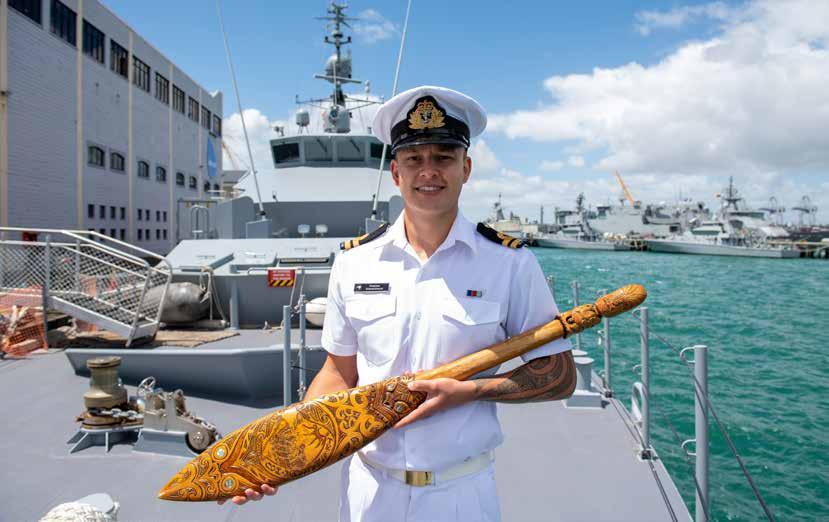
4 minute read
Taking command of HMNZS TAUPO
NEW CO FOR TAUPO
Nelson man Fletcher Slierendrecht is the Royal New Zealand Navy’s newest Commanding Officer, taking command of HMNZS TAUPO last month.
Advertisement
Lieutenant Slierendrecht, 26, assumed command of the 55-metre Inshore Patrol Vessel in a ceremony at Devonport Naval Base on 29 January. He was asked if he would like to have his name put forward for the job, and it’s a question that makes you stop and think, he says. “You picture yourself as a Commanding Officer. You ask: are you ready for it? I wasn’t expecting a nomination for another year or two. But it’s very pleasing to find out you’ve been chosen.” He joined the Navy after finishing at Nayland College in 2013. “I wasn’t sure what I was going to do. A career roadshow came to Nelson, and the Defence Force had their recruitment bus. It sparked my attention and it sounded pretty cool. I’m from a very outdoor-oriented family and I’ve grown up with boats. My parents said, why don’t you apply, give it a shot?” He joined the Navy in 2014, aged 18, arriving in Auckland for the first time ever to start his Junior Officer training. “It’s a big adjustment, and you do question yourself. That’s when you stop, look around, see the people around you. You can see everyone’s similar, all doing it together, so you think, let’s get it done. The hardest part about training is the cutting off of support. You’ve got plenty of support from your peers, but think about it – you’re an 18-year-old in your first job, you’re with a bunch of strangers in the military, and you don’t have a cellphone or the ability to talk to family. You find out if you’ve got what it takes.” As a Warfare Officer, he started his training on sister ships to TAUPO, spending time in HMNZS ROTOITI, HAWEA, then on frigates and offshore patrol vessels. He was deployed in TAUPO as Navigating Officer during that vessel’s fisheries patrol mission in Fiji in 2018. “That’s my highlight, that mission. It was my first navigator job, and it was an awesome professional challenge, to take an IPV out of its usual routine and into a coral environment internationally.” Other highlights include a South East Asia tour in HMNZS TE KAHA in 2017 and an exchange with the US Navy, serving on an aircraft carrier and a destroyer. He would tell today’s year-13 students there are a lot of options in the Navy. “It’s actually a pretty good lifestyle, especially if you don’t know what you’re doing when you finish school. The Navy will put you through study if you want to go to university later. It pays well, and the work is pretty engaging. It’s a cool job.” His work with TAUPO this year will be teaching junior warfare officers their trade, interspersed with fisheries and customs patrols around New Zealand.
New Safety Event Management Tool
Prepare for ‘go live’ on 9 March
By Commander Raymond McLaughlin
Director of Naval Safety and Health

In my October update last year, I told you about the new NZDF-wide safety reporting and risk management tool – the SEMT (Safety Event Management Tool), and how it will help support the NZDF to look after our people and minimise the risk of harm to everyone.
In brief, the SEMT will be the place where you will report a safety event (such as an incident or accident, a safety concern, or a positive initiative or intervention —“something good”). It will also provide one place for entering and viewing safety risk assessments. From 9 March, we will start using the SEMT for reporting all safety events and managing safety risks and stop using systems like N-SHAIR [ashore] and OSHBASE.
What about deployed ships?
During periods of deployment, ships will continue to use N-SHAIR. Events recorded in N-SHAIR will then be transferred to the SEMT so that we have a complete picture of Naval Safety in one place. This arrangement will remain in place until the SEMT can be deployed onto ships at sea. For those with no DIXS access, reporting through a paper form will be possible.
Preparing for ‘go live’
The best way to prepare for the SEMT going live is by attending an introductory overview presentation near you. These will be delivered throughout February and early March, with times and locations widely advertised. Make sure to go along to one of them.
For most people, attending the overview presentation is all the training they will require, as the new tool is easy to use. But if you want to find out more about the SEMT, visit the SEMT information page on DIXS. You can find this page via the ILP, by clicking on the ‘Safety’ button in the right-hand side menu. (Once it goes live, you will also be able to access the SEMT via the same path.)








